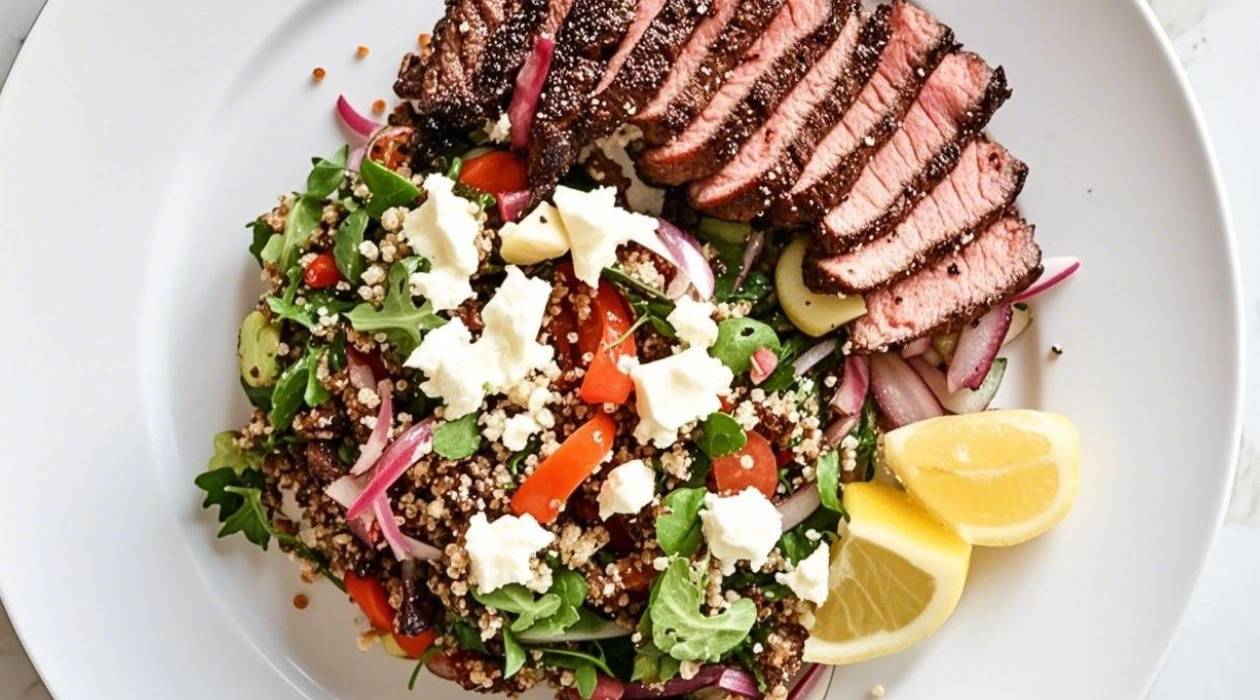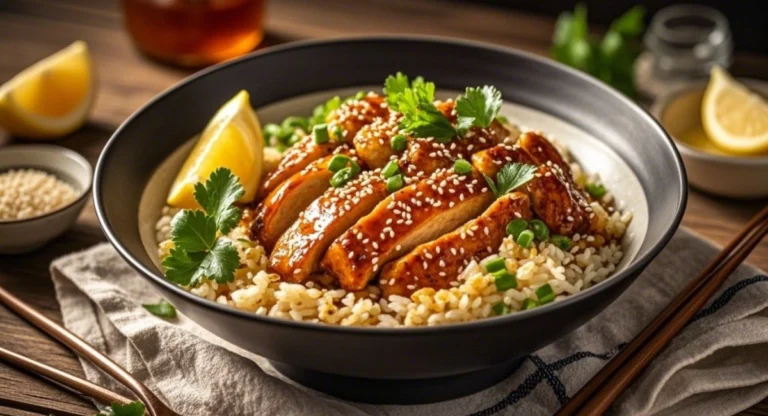Delicious Mediterranean Steak Bowls: Fresh, Healthy & Easy Meals for Busy Weeknights
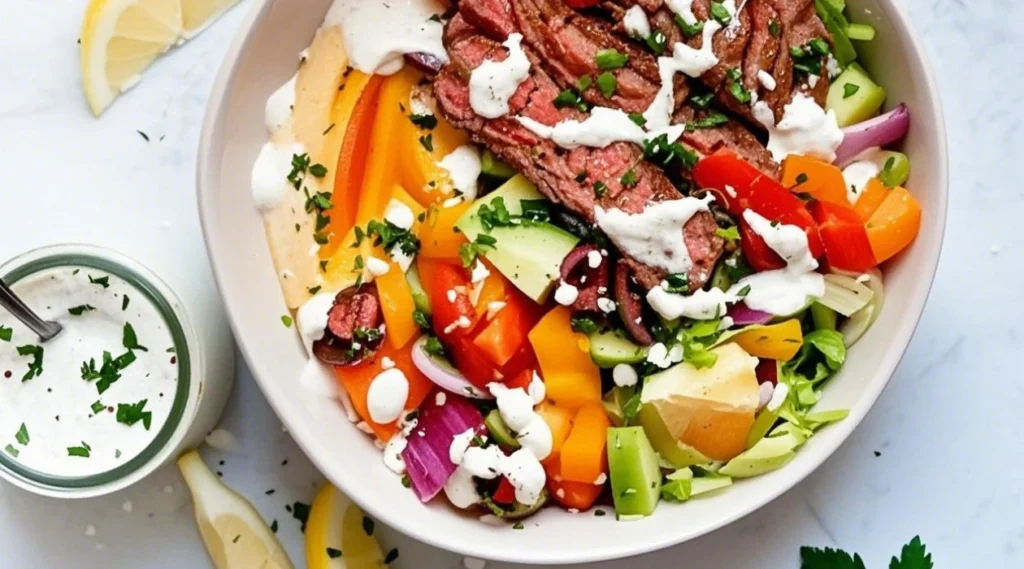
Table of Contents
Finding Joy in Simple Mediterranean Cooking
Picture this: It’s 7 PM on a Wednesday. You’re exhausted after a long workday, but the thought of another takeout meal makes your wallet and waistline groan in unison. What if you could be savoring a restaurant-worthy Mediterranean steak bowl in less than 30 minutes? That moment when your fork pierces perfectly seasoned steak alongside roasted vegetables and cool, creamy tzatziki – it transforms an ordinary weeknight into something extraordinary.
These vibrant bowls aren’t just visually appealing; they represent everything wonderful about Mediterranean cuisine: fresh ingredients, bold flavors, and nourishing components that leave you satisfied without feeling weighed down. Whether you’re cooking for yourself after a hectic day or preparing a casual dinner gathering with friends, these versatile bowls deliver both convenience and culinary delight.
What Makes Mediterranean Steak Bowls a Perfect Weeknight Meal
Mediterranean cuisine has captured hearts worldwide, and for good reason. The Mediterranean diet consistently ranks among nutritionists’ top recommendations, with research from the Mayo Clinic confirming its benefits for heart health, longevity, and cognitive function. But beyond the impressive health credentials lies something equally important: meals that actually taste incredible.
Mediterranean steak bowls excel in virtually every category that matters for weeknight dining:
- They strike the perfect balance of protein, complex carbohydrates, and healthy fats
- Most components can be prepared in advance
- The entire meal comes together in under 30 minutes when organized properly
- Base ingredients are versatile enough to work with whatever happens to be in your refrigerator
- The cost per serving typically falls well below comparable restaurant offerings
- Their customizable nature accommodates diverse dietary needs and preferences
Perhaps most importantly, these vibrant bowls deliver layered flavors and varying textures that satisfy far more deeply than most quick-assembly meals. The combination of warm grains, cool vegetables, tender meat, and tangy sauces creates an eating experience that feels intentional rather than rushed – a rare achievement for weeknight cooking.
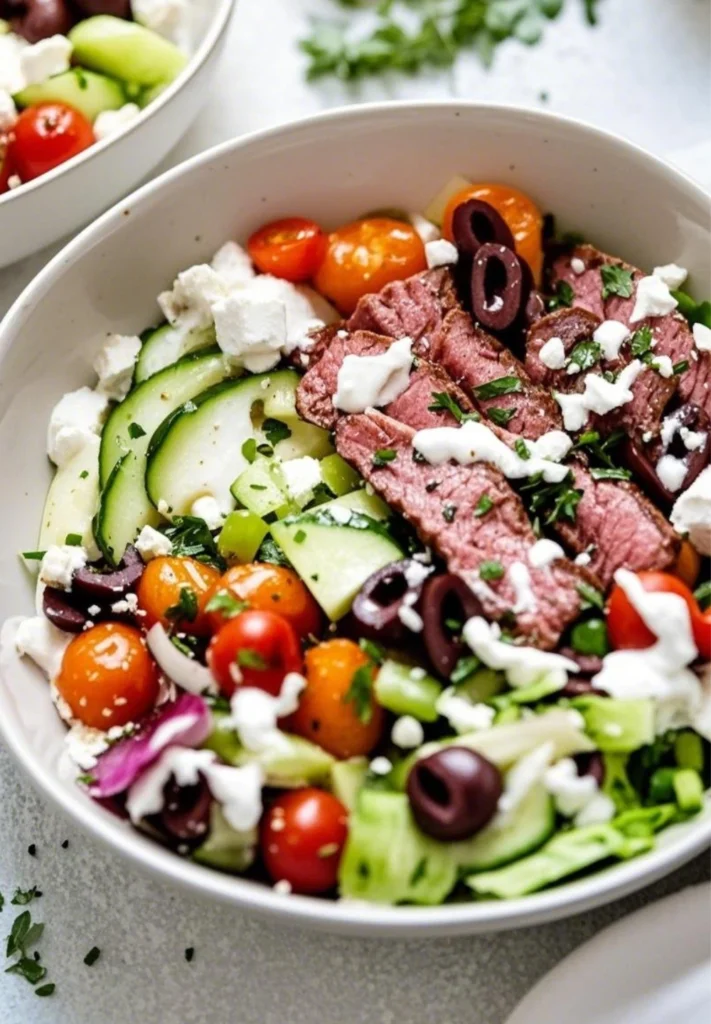
The Nutritional Powerhouse Behind Mediterranean Steak Bowls
Heart-Healthy Components
The Mediterranean diet has earned its stellar reputation through decades of research confirming its heart-protective qualities. According to a landmark study published in the New England Journal of Medicine, participants following Mediterranean-style eating patterns demonstrated a 30% lower risk of major cardiovascular events.
Mediterranean steak bowls incorporate key elements of this diet:
Extra virgin olive oil serves as the primary fat source, delivering monounsaturated fatty acids that help maintain healthy cholesterol levels. Unlike heavily processed oils, olive oil contains polyphenols with powerful antioxidant properties.
Fresh vegetables contribute vital micronutrients along with fiber. The vibrant colors in your bowl – the deep reds of tomatoes, verdant greens of herbs, and bright yellows of bell peppers – signal the presence of different phytonutrients that combat inflammation and oxidative stress.
Lean beef, when enjoyed in moderate portions, provides high-quality protein along with iron, zinc, and B vitamins essential for energy production and immune function. Selecting grass-fed options whenever possible further enhances the nutritional profile by improving the fatty acid composition.
Mediterranean Diet Principles Applied to Modern Meals
What makes Mediterranean steak bowls particularly brilliant is how they adapt time-honored principles to contemporary lifestyles. Traditional Mediterranean eating emphasizes:
- An abundance of plant foods
- Limited red meat consumption
- Emphasis on whole, minimally processed ingredients
- Sharing meals as a social experience
- Savoring flavors mindfully
Your Mediterranean steak bowl transforms these principles into a practical format for today’s eating patterns. The bowl presentation naturally encourages proper portion control for animal proteins while allowing plant components to shine. The varied ingredients ensure balanced macronutrient distribution – protein from steak, complex carbohydrates from whole grains, and healthy fats from olive oil and perhaps some avocado or olives.
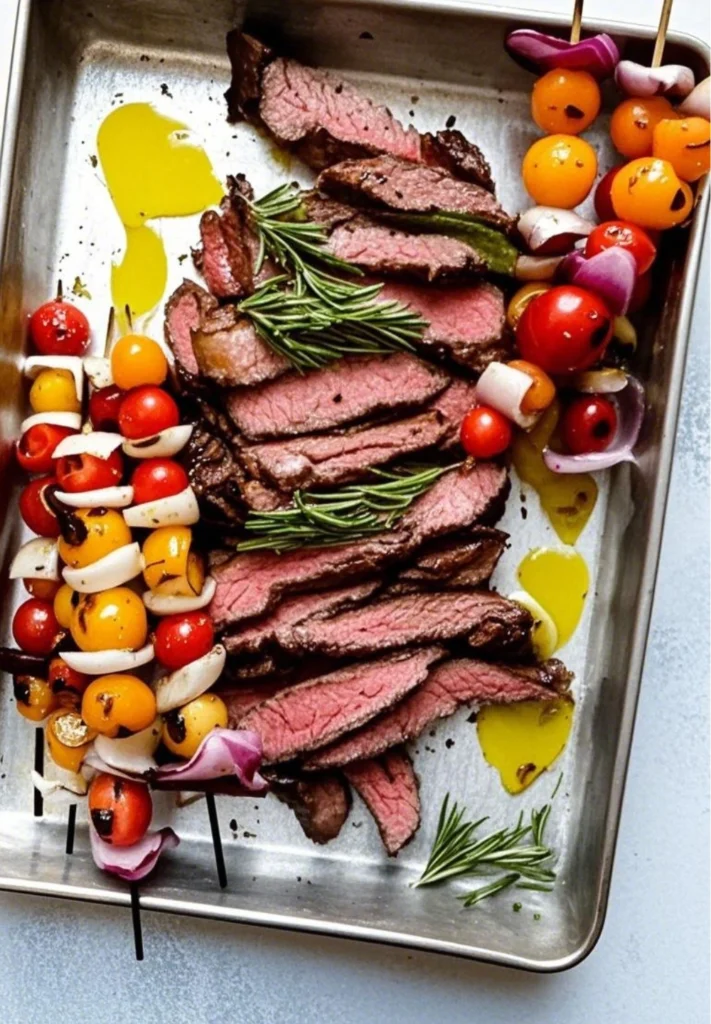
Essential Ingredients for Perfect Mediterranean Steak Bowls
Selecting the Right Cut of Steak
The foundation of your Mediterranean bowl begins with selecting appropriate beef. While traditional Mediterranean diets use meat sparingly as a flavor accent rather than a centerpiece, modern interpretations often feature it more prominently for protein-focused meals.
For weeknight cooking, prioritize cuts that cook quickly while remaining tender:
Flank steak offers exceptional flavor and responds beautifully to marinades. Its distinctive grain requires slicing against the muscle fibers (perpendicular to the visible lines) for maximum tenderness.
Sirloin provides excellent value, delivering steak-house quality when cooked properly. Look for top sirloin when available, as it balances tenderness with robust flavor.
Skirt steak, despite its sometimes intimidating appearance, transforms into something spectacular with minimal effort. Its intense beef flavor makes a little go a long way.
Regardless of your chosen cut, quality matters. Seek out options from responsibly raised animals whenever your budget permits. When selecting budget-friendly cuts, proper cooking technique becomes even more crucial – a brief marinade containing acidic components (lemon juice, vinegar) helps tenderize economical options.
Mediterranean Staple Ingredients
| Ingredient Category | Essential Items | Benefits |
|---|---|---|
| Proteins | Grass-fed beef, lamb, chicken | Complete proteins, B vitamins, iron |
| Grains | Quinoa, bulgur, farro | Fiber, complex carbohydrates |
| Vegetables | Tomatoes, cucumbers, bell peppers | Vitamins, minerals, fiber |
| Herbs & Spices | Oregano, mint, cumin, sumac | Antioxidants, flavor enhancers |
| Healthy Fats | Olive oil, avocado, olives | Heart-healthy fats, satiety |
| Dairy | Greek yogurt, feta cheese | Calcium, probiotics |
The true magic of Mediterranean cooking emerges from combining seemingly simple ingredients in ways that elevate the whole beyond its parts. Fresh herbs play an outsized role here – a handful of chopped mint or dill transforms ordinary ingredients into something memorable. Similarly, finishing your bowl with a squeeze of fresh lemon juice brightens flavors throughout the dish.
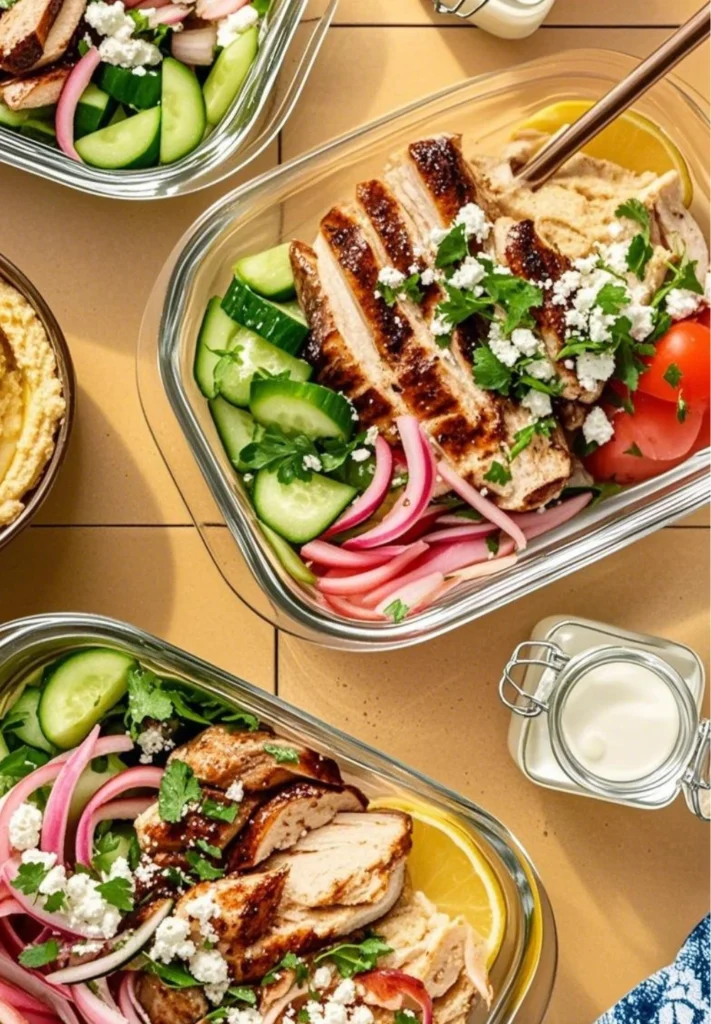
Step-by-Step Mediterranean Steak Bowl Recipe
Perfectly Seasoned Steak Preparation
- Begin with room temperature steak (removing it from refrigeration 30 minutes before cooking)
- Pat meat dry thoroughly with paper towels to promote browning
- Season generously with kosher salt, freshly ground black pepper, dried oregano, and garlic powder
- For enhanced flavor, consider a quick marinade of olive oil, lemon juice, minced garlic, and herbs (minimum 15 minutes, ideally 2 hours)
- Heat a cast-iron skillet until smoking hot
- Add a small amount of high-heat oil (grapeseed or avocado)
- Sear steak 3-4 minutes per side for medium-rare (adjust timing based on thickness)
- Transfer to cutting board and rest uncovered for at least 5 minutes
- Slice thinly against the grain at a slight angle
The resting period proves absolutely essential – skip this step and precious juices escape, leaving your centerpiece protein disappointingly dry. While resting, your steak continues cooking slightly through residual heat, allowing internal temperatures to equalize.
Building Your Mediterranean Steak Bowl Base
| Base Option | Cooking Method | Flavor Profile |
|---|---|---|
| Quinoa | Stovetop/Instant Pot | Nutty, fluffy |
| Bulgur | Quick-soak method | Hearty, chewy |
| Cauliflower rice | Sauté | Light, low-carb |
| Mixed greens | Fresh | Crisp, refreshing |
Your chosen base anchors the entire bowl, both literally and figuratively. For warm bases like quinoa, consider cooking in broth rather than water for added depth, and always finish with a drizzle of your finest olive oil and a pinch of flaky sea salt. For leafy options, a light toss with lemon juice and olive oil prevents flavors from becoming muddled once other components join the party.
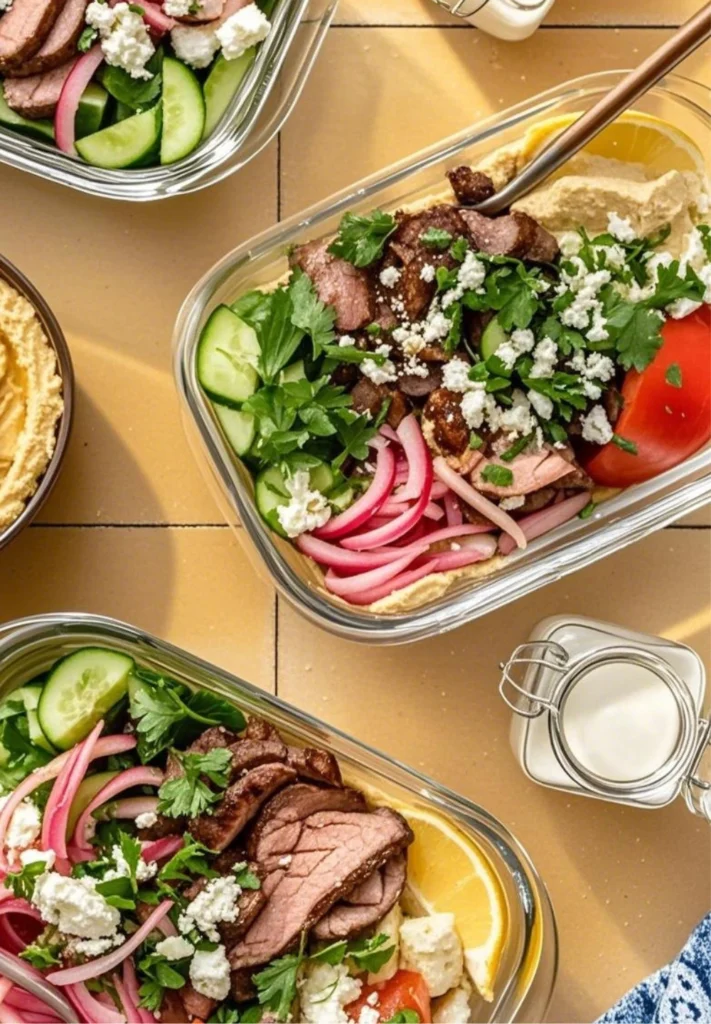
Mediterranean Vegetable Medley
Mediterranean cuisine celebrates vegetables in their glorious simplicity. Roasting transforms everyday produce into caramelized versions of themselves, concentrating flavors while requiring minimal hands-on attention.
For quick-roasted vegetables:
- Cut vegetables into uniform pieces (approximately 1-inch)
- Toss lightly with olive oil, salt, and dried herbs (oregano, thyme)
- Spread in single layer on baking sheet
- Roast at 425°F until edges caramelize (typically 15-20 minutes)
- Finish with fresh herbs immediately after removing from oven
Raw vegetables contribute essential textural contrast and freshness. Try thinly sliced radishes, cucumber half-moons, or cherry tomatoes halved and quickly tossed with olive oil, lemon juice, and flaky salt.
Homemade Sauces That Elevate Your Mediterranean Steak Bowl
- Classic Tzatziki:
- 1 cup Greek yogurt (full-fat preferred)
- 1 cucumber, grated and excess moisture squeezed out
- 2 garlic cloves, microplaned or finely minced
- 1 tablespoon extra virgin olive oil
- 1 tablespoon fresh lemon juice
- 2 tablespoons chopped fresh dill or mint
- Salt and pepper to taste
- Combine ingredients, then refrigerate minimum 30 minutes before serving
- Lemon-Herb Tahini Drizzle:
- ¼ cup tahini
- 3 tablespoons fresh lemon juice
- 1 small garlic clove, microplaned
- 2-3 tablespoons water (adjust for desired consistency)
- 2 tablespoons chopped fresh parsley
- Pinch of cumin
- Salt to taste
- Whisk ingredients until smooth, adding water gradually
The right sauce ties every element together while adding moisture and richness. Consider preparing double batches to use throughout the week on other dishes – properly stored in airtight containers, most Mediterranean sauces remain fresh for 4-5 days.
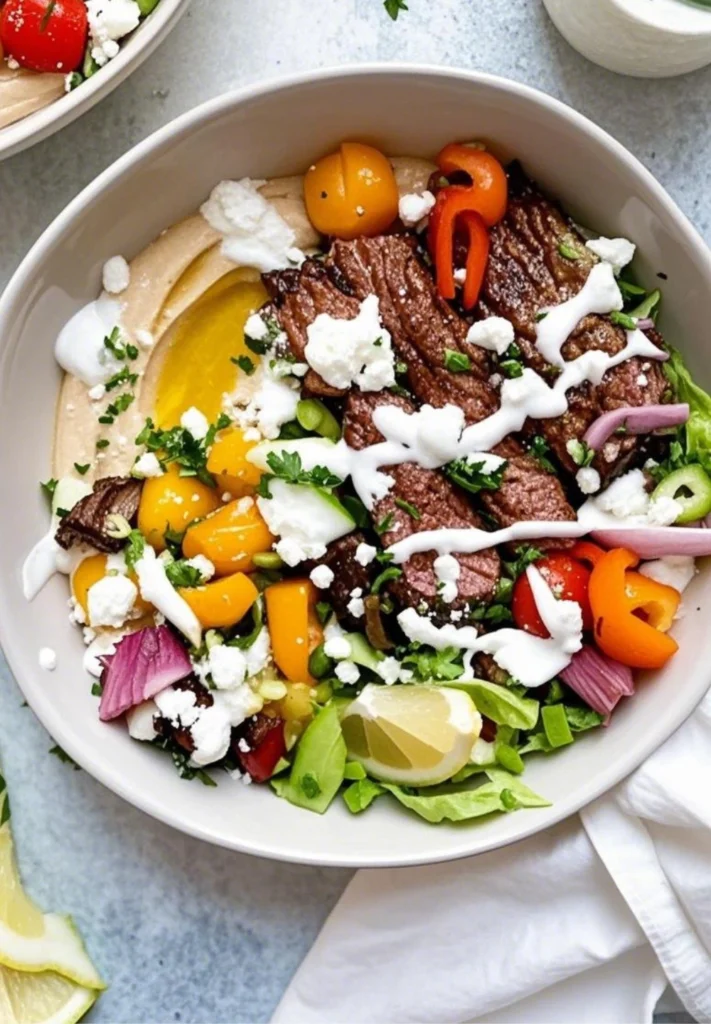
Mediterranean Steak Bowl Variations to Keep Meals Exciting
Greek-Inspired Mediterranean Steak Bowl
Transport yourself to the Greek isles with this classic combination:
- Lemon-oregano marinated flank steak
- Quinoa base tossed with olive oil and lemon
- Cherry tomatoes, cucumber, and red onion
- Kalamata olives
- Crumbled feta cheese
- Tzatziki sauce
- Fresh mint and oregano
Moroccan-Spiced Mediterranean Steak Bowl
Venture toward North African flavors with warming spices:
- Cumin and coriander-rubbed sirloin
- Bulgur wheat with dried apricots and toasted almonds
- Roasted carrots with honey glaze
- Chickpeas tossed with olive oil and spices
- Harissa-spiked yogurt
- Fresh cilantro
Italian Countryside Mediterranean Steak Bowl
The rustic flavors of Tuscany shine in this hearty variation:
- Rosemary and garlic marinated steak
- Farro base with olive oil and balsamic
- Roasted cherry tomatoes and zucchini
- White beans tossed with olive oil and herbs
- Basil pesto drizzle
- Fresh basil leaves
Vegetarian and Vegan Alternatives
Mediterranean cuisine naturally celebrates plant-based eating. For meatless versions:
- Substitute portobello mushrooms marinated in balsamic vinegar
- Consider grilled halloumi cheese (for vegetarians)
- Incorporate protein-rich legumes like lentils or chickpeas
- Try herb-marinated tofu or tempeh
- Increase healthy fat content with additional avocado or nuts

Meal Prep Tips for Make-Ahead Mediterranean Steak Bowls
Transform your Sunday afternoon into a meal prep session that sets you up for Mediterranean-inspired lunches throughout the week:
- Cook proteins and grains in batches (steak remains good for 3-4 days when refrigerated properly)
- Store components in separate glass containers
- Prepare dressings and sauces in advance, but store separately
- Keep fresh herbs between damp paper towels in sealed containers
- Wait to slice avocados until serving time
- Assemble bowls the morning of or night before consumption
Glass containers with compartments work exceptionally well, allowing you to maintain separation between wet and dry ingredients until eating time. For maximum freshness, place any dressed greens or delicate herbs at the top of your container.
Wine and Beverage Pairings for Mediterranean Steak Bowls
The right beverage complements your Mediterranean steak bowl, enhancing flavors rather than competing with them:
For Greek-inspired bowls, consider an assyrtiko from Santorini – its mineral character and bright acidity cut through rich yogurt-based sauces beautifully.
Moroccan variations pair wonderfully with grenache blends from Southern Rhône – their spice notes echo the warming spices in the dish.
Italian-style bowls call for sangiovese-based wines like Chianti Classico, whose cherry notes and earthy undertones complement both beef and tomatoes.
For non-alcoholic options:
- Sparkling water infused with cucumber and mint
- Pomegranate juice mixed with sparkling water
- Traditional Greek mountain tea served iced
- Moroccan mint tea (either hot or iced)
Embracing the Mediterranean Lifestyle One Bowl at a Time
Bringing the Mediterranean to your dinner table isn’t just about enjoying a delicious meal – it’s about embracing a lifestyle that prioritizes both pleasure and health. These Mediterranean steak bowls represent more than just dinner; they’re a small daily ritual that connects you to centuries of culinary wisdom while fitting perfectly into your modern life.
The Mediterranean approach reminds us that meals needn’t be complicated to be exceptional. By starting with quality ingredients, treating them with respect, and sharing them with others whenever possible, even weeknight dinners become opportunities for nourishment beyond mere sustenance.
Whether preparing these bowls for yourself after a demanding day, sharing them with your family around the kitchen table, or adapting components for a casual gathering with friends, you’re participating in something timeless – finding joy in simple food, thoughtfully prepared and mindfully enjoyed.
Begin your Mediterranean journey tonight. Your waistline, wallet, and taste buds will thank you.
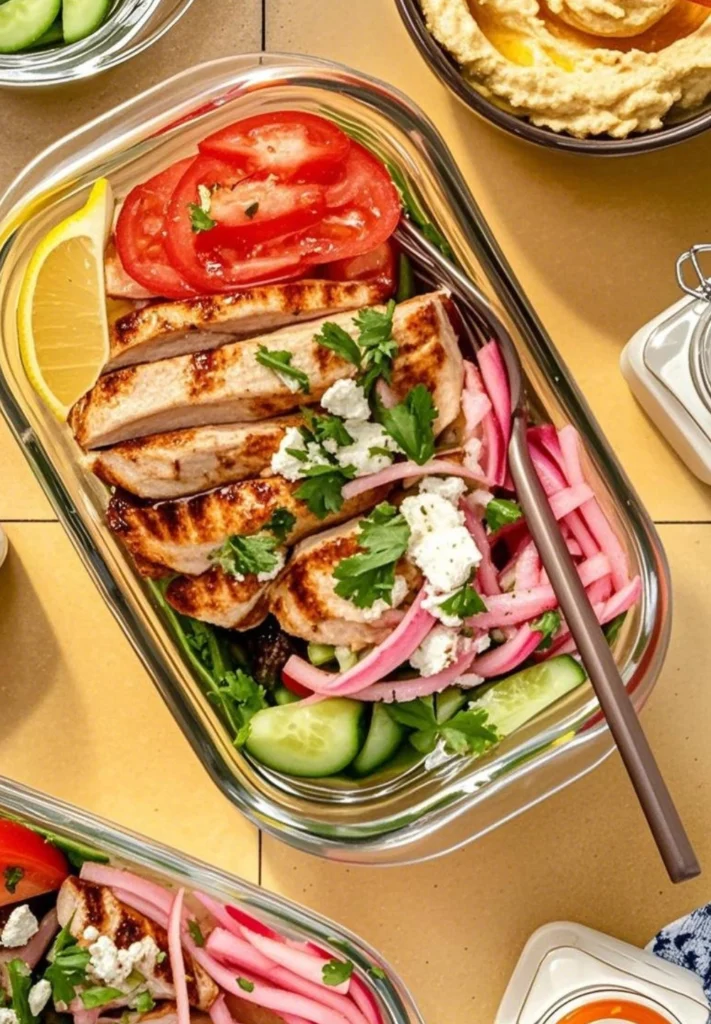
Frequently Asked Questions About Mediterranean Steak Bowls
What cuts of beef work best for Mediterranean steak bowls?
The most suitable cuts for Mediterranean steak bowls include flank steak, sirloin, and skirt steak, which balance tenderness with flavor while cooking quickly enough for weeknight meals. These cuts respond exceptionally well to Mediterranean-inspired marinades containing olive oil, lemon juice, and herbs, creating foundation protein that complements the fresh components in your bowl.
Can I prepare Mediterranean steak bowls ahead of time for meal prep?
Yes, Mediterranean steak bowls excel for meal preparation! Store components separately, with sauces isolated from other ingredients until serving time. Cook grains and proteins in batches, then refrigerate in sealed containers. Roasted vegetables maintain their texture for 3-4 days when properly stored. For optimal freshness, add delicate herbs, greens, and dressings just before consuming your prepared bowl.
How can I make Mediterranean steak bowls more budget-friendly?
Create economical Mediterranean steak bowls by watching for sales on steak cuts, incorporating more seasonal vegetables, extending protein with beans or lentils, and buying herbs in small amounts from bulk sections. Consider less expensive cuts like chuck eye or ranch steak when properly prepared. Remember that Mediterranean cooking traditionally uses meat as a flavor accent rather than the main focus – embracing this authentic approach naturally reduces costs.
Are Mediterranean steak bowls suitable for special diets?
Mediterranean steak bowls adapt beautifully to various dietary needs. For low-carb/keto versions, substitute cauliflower rice or additional greens for traditional grains. Omit dairy components and focus on tahini-based sauces for dairy-free alternatives. Vegetarians can enjoy these bowls by replacing steak with grilled halloumi, while vegans might incorporate marinated portobello mushrooms or herbed tempeh. The flexible format easily accommodates gluten-free, paleo, and other specialized eating patterns.
What makes Mediterranean steak bowls healthier than other quick dinner options?
Mediterranean steak bowls surpass typical quick meals by incorporating key elements of the Mediterranean diet – balanced portions of lean proteins, abundant vegetables, whole grains, and heart-healthy fats – while minimizing processed ingredients. Their emphasis on fresh herbs and spices reduces reliance on excessive salt or sugar for flavor. The bowl format naturally encourages thoughtful portion control across food groups, resulting in a satisfying meal that nourishes rather than merely fills.

